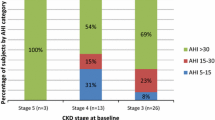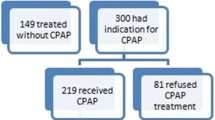Abstract
Purpose
The purpose of the present study was to evaluate the influence of continuous positive airway pressure (CPAP) on serum cystatin C, a novel biomarker of early renal impairment, among obstructive sleep apnea (OSA) patients.
Materials and methods
Newly diagnosed severe OSA patients who treated with CPAP for 3 months were enrolled from two sleep laboratories. Serum biomarkers of renal impairment, cystatin C, creatinine and estimated glomerular filtration rate (eGFR), were detected before and after CPAP treatment.
Results
A total of 39 severe OSA patients were enrolled, 29 (74.4 %) were male, and mean age was 51.2 ± 12.2 years. After CPAP treatment, there were no changes of creatinine and eGFR (77.80 ± 20.00 vs. 75.3 ± 16.60 and 98.69 ± 31.74 vs. 100.20 ± 28.30, all p > 0.05), but cystatin C declined significantly (0.87 ± 0.18 vs. 0.77 ± 0.21, p = 0.000).
Conclusion
CPAP can decrease cystatin C levels among severe OSA patients and may prevent the latent renal impairment.


Similar content being viewed by others
References
Peppard PE, Young T, Palta M, Skatrud J (2000) Prospective study of the association between sleep-disordered breathing and hypertension. N Engl J Med 342:1378–1384
Marin JM, Carrizo SJ, Vicente E, Agusti AG (2005) Long-term cardiovascular outcomes in men with obstructive sleep apnoea-hypopnoea with or without treatment with continuous positive airway pressure: an observational study. Lancet 365:1046–1053
Nicholl DD, Ahmed SB, Loewen AH, Hemmelgarn BR, Sola DY, Beecroft JM, Turin TC, Hanly PJ (2012) Declining kidney function increases the prevalence of sleep apnea and nocturnal hypoxia. Chest 141:1422–1430
Kimmel PL, Miller G, Mendelson WB (1989) Sleep apnea syndrome in chronic renal disease. Am J Med 86:308–314
Molnar MZ, Szentkiralyi A, Lindner A, Czira ME, Szabo A, Mucsi I, Novak M (2007) High prevalence of patients with a high risk for obstructive sleep apnoea syndrome after kidney transplantation: association with declining renal function. Nephrol Dial Transplant 22:2686–2692
Fornadi K, Lindner A, Czira ME, Szentkiralyi A, Lazar AS, Zoller R, Turanyi CZ, Veber O, Novak M, Mucsi I, Molnar MZ (2012) Lack of association between objectively assessed sleep disorders and inflammatory markers among kidney transplant recipients. Int Urol Nephrol 44:607–617
Faulx MD, Storfer-Isser A, Kirchner HL, Jenny NS, Tracy RP, Redline S (2007) Obstructive sleep apnea is associated with increased urinary albumin excretion. Sleep 30:923–929
Ahmed SB, Ronksley PE, Hemmelgarn BR, Tsai WH, Manns BJ, Tonelli M, Klarenbach SW, Chin R, Clement FM, Hanly PJ (2011) Nocturnal hypoxia and loss of kidney function. PLoS One 6:e19029
Chou YT, Lee PH, Yang CT, Lin CL, Veasey S, Chuang LP, Lin SW, Lin YS, Chen NH (2011) Obstructive sleep apnea: a stand-alone risk factor for chronic kidney disease. Nephrol Dial Transplant 26(7):2244–2250
Mello P, Franger M, Boujaoude Z, Adaimy M, Gelfand E, Kass J, Weisberg LS (2004) Night and day proteinuria in patients with sleep apnea. Am J Kidney Dis 44:636–641
Shlipak MG, Matsushita K, Arnlov J, Inker LA, Katz R, Polkinghorne KR, Rothenbacher D, Sarnak MJ, Astor BC, Coresh J, Levey AS, Gansevoort RT, Consortium CKDP (2013) Cystatin C versus creatinine in determining risk based on kidney function. N Engl J Med 369:932–943
Pavkov ME, Knowler WC, Hanson RL, Williams DE, Lemley KV, Myers BD, Nelson RG (2013) Comparison of serum cystatin C, serum creatinine, measured GFR, and estimated GFR to assess the risk of kidney failure in American Indians with diabetic nephropathy. Am J Kidney Dis 62:33–41
Kato K, Takata Y, Usui Y, Shiina K, Asano K, Hashimura Y, Saruhara H, Nishihata Y, Tomiyama H, Yamashina A (2011) Severe obstructive sleep apnea increases cystatin C in clinically latent renal dysfunction. Respir Med 105:643–649
Zhang XB, Lin QC, Deng CS, Chen GP, Cai ZM, Chen H (2013) Elevated serum cystatin C in severe OSA younger men without complications. Sleep Breath 17:235–241
Zhang XB, Lin QC, Chen GP (2013) Significance of serum cystatin C in elderly patients with obstructive sleep apnea hypopnea syndrome (in Chinese). Chin J Geriatr 32:1058–1061
American Thoracic Society (1994) Indications and standards for use of nasal continuous positive airway pressure (CPAP) in sleep apnea syndromes. Am J Respir Crit Care Med 150:1738–1745
Risch L, Herklotz R, Blumberg A, Huber AR (2001) Effects of glucocorticoid immunosuppression on serum cystatin C concentrations in renal transplant patients. Clin Chem 47:2055–2059
Fricker M, Wiesli P, Brandle M, Schwegler B, Schmid C (2003) Impact of thyroid dysfunction on serum cystatin C. Kidney Int 63:1944–1947
Levey AS, Bosch JP, Lewis JB, Greene T, Rogers N, Roth D (1999) A more accurate method to estimate glomerular filtration rate from serum creatinine: a new prediction equation. Modification of Diet in Renal Disease Study Group. Ann Intern Med 130:461–470
Young T, Palta M, Dempsey J, Skatrud J, Weber S, Badr S (1993) The occurrence of sleep-disordered breathing among middle-aged adults. N Engl J Med 328:1230–1235
Ryan S, Taylor CT, McNicholas WT (2005) Selective activation of inflammatory pathways by intermittent hypoxia in obstructive sleep apnea syndrome. Circulation 112:2660–2667
Lavie L, Kraiczi H, Hefetz A, Ghandour H, Perelman A, Hedner J, Lavie P (2002) Plasma vascular endothelial growth factor in sleep apnea syndrome: effects of nasal continuous positive air pressure treatment. Am J Respir Crit Care Med 165:1624–1628
Schulz R, Mahmoudi S, Hattar K, Sibelius U, Olschewski H, Mayer K, Seeger W, Grimminger F (2000) Enhanced release of superoxide from polymorphonuclear neutrophils in obstructive sleep apnea. Impact of continuous positive airway pressure therapy. Am J Respir Crit Care Med 162:566–570
Markou N, Kanakaki M, Myrianthefs P, Hadjiyanakos D, Vlassopoulos D, Damianos A, Siamopoulos K, Vasiliou M, Konstantopoulos S (2006) Sleep-disordered breathing in nondialyzed patients with chronic renal failure. Lung 184:43–49
Fein AM, Niederman MS, Imbriano L, Rosen H (1987) Reversal of sleep apnea in uremia by dialysis. Arch Intern Med 147:1355–1356
Zoccali C, Benedetto FA, Mallamaci F, Tripepi G, Candela V, Labate C, Tassone F (2001) Left ventricular hypertrophy and nocturnal hypoxemia in hemodialysis patients. J Hypertens 19:287–293
Yamauchi M, Nakano H, Maekawa J, Okamoto Y, Ohnishi Y, Suzuki T, Kimura H (2005) Oxidative stress in obstructive sleep apnea. Chest 127:1674–1679
Kanbay A, Buyukoglan H, Ozdogan N, Kaya E, Oymak FS, Gulmez I, Demir R, Kokturk O, Covic A (2012) Obstructive sleep apnea syndrome is related to the progression of chronic kidney disease. Int Urol Nephrol 44:535–539
Canales MT, Taylor BC, Ishani A, Mehra R, Steffes M, Stone KL, Redline S, Ensrud KE, Osteoporotic Fractures in Men Study G (2008) Reduced renal function and sleep-disordered breathing in community-dwelling elderly men. Sleep Med 9:637–645
Krieger J, Imbs JL, Schmidt M, Kurtz D (1988) Renal function in patients with obstructive sleep apnea. Effects of nasal continuous positive airway pressure. Arch Intern Med 148:1337–1340
Margel D, Shochat T, Getzler O, Livne PM, Pillar G (2006) Continuous positive airway pressure reduces nocturia in patients with obstructive sleep apnea. Urology 67:974–977
Koga S, Ikeda S, Yasunaga T, Nakata T, Maemura K (2013) Effects of nasal continuous positive airway pressure on the glomerular filtration rate in patients with obstructive sleep apnea syndrome. Intern Med 52:345–349
Acknowledgments
This work was supported by grant 2013-2-88 for Youth Research Fund from Fujian Provincial Health Bureau.
Conflict of interest
The authors declare that they have no conflict of interest.
Author information
Authors and Affiliations
Corresponding author
Additional information
All authors contributed equally to this work.
Rights and permissions
About this article
Cite this article
Zhang, XB., Jiang, XT., Lin, QC. et al. Effect of continuous positive airway pressure on serum cystatin C among obstructive sleep apnea syndrome patients. Int Urol Nephrol 46, 1997–2002 (2014). https://doi.org/10.1007/s11255-014-0779-x
Received:
Accepted:
Published:
Issue Date:
DOI: https://doi.org/10.1007/s11255-014-0779-x




